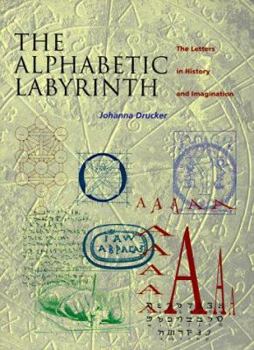Alphabetic Labyrinth: The Letters in History and Imagination
Select Format
Select Condition 
Book Overview
The letters of the alphabet have been the source of some speculation since their invention almost 4000 years ago. Through research this text examines the many ways in which the letters of the alphabet... This description may be from another edition of this product.
Format:Hardcover
Language:English
ISBN:0500016089
ISBN13:9780500016084
Release Date:January 1995
Publisher:Thames & Hudson
Length:320 Pages
Weight:2.65 lbs.
Dimensions:1.3" x 7.8" x 10.5"
Customer Reviews
5 ratings
Incredible information
Published by Thriftbooks.com User , 22 years ago
This book presents so much information, but does it in such a way, that I could not put this book down, with the exception to absorb what I had just read. This is an excellent book for anyone interested in not only the genesis of the alphabet and it's morphology, but of other symbols as well, including alchemy symbols.
Missing the Point
Published by Thriftbooks.com User , 22 years ago
A reader reviewed this book by Joanna Drucker as not being enough informative on the alphabet history in itself. It's unfair and not informate to review the book like this. Its manifesto is all in the evocative title: The Alphabetic Labyrinth: The Letters in History and Imagination. Joanna Drucker traced an history of the alphabet from the very beginning talking about the interesting and often left apart complex variety of meanings of the letterform, embodied by mystery, symbolic, alchemic, religious, esotheric and many other values, offering an unique showcase of the history of writing. Saying the book is unsatisfying equals to say you have not even read the title, which explains quite well its content!
informative, insightful and well written
Published by Thriftbooks.com User , 25 years ago
This book is truly a history of the alphabet. The author is very informative. She gives a good historical background and overview of written language. I especially liked Chapter VI The Kabbalah. The author writes in a clear, detailed manner as she traces the alphabet through history and the imagination. Perhaps the most difficult aspect of the book is trying to relate the way different people in different epochs have veiwed the alphabet, letters, and written language. Druker does this well. She includes many helpful examples and diagrams. Anyone interested in written language would enjoy this book.
The seventh chapter is a rich Renaissance tapestry.
Published by Thriftbooks.com User , 26 years ago
In The Alphabetic Labyrinth: The Letters in History and Imagination, Johanna Drucker presents a thorough investigation of the alphabet as it relates to the Western tradition of intellectual development. Her purpose is to trace alphabet symbolism through the course of history and tradition while also discussing the origins and development of the alphabet itself. Chapter seven, titled "Rationalizing the Alphabet: Construction, Real Character and Philosophical Languages in the Renaissance" covers alphabet history during the Renaissance - an age that favored a cosmological view of the world, an age when the highly structured and the rigidly hierarchial were considered manifestations of the divine and an age that saw a blend of mystical, occult and intellec- tual traditions. Drucker interweaves these cultural threads with the various people of the Renaissance who used and seriously studied the alphabet during that period in history that is recognized by the invention of printing. After Guttenberg's bible in 1456, the spread of printing throughout Europe was a quick process that produced many ripples in the fabric of culture. Printing was responsible for the production and dissemination of books and for a proliferation of type styles as well. Page design became more linear and regularized. Alphabetic writing itself became standardized. Text types took their visual form from manuscript faces and the development of capital letters returned to the tradition of Roman capitals which became even more elaborate and decorative during the Renaissance. However, letter designers recon- ceptualized the forms of majuscules or capitals in this period through a process of complicated, highly rationalized construction. The compass and the square were often considered necessary to achieve a set of proportions for the width of the major strokes to fit theoretical models. Constructed alphabets were designed by a profusion of geometers, mathematicians, writing masters and printers. Fra Luca de Pacioli's designs were possibly developed with Leonardo de Vinci. Durer's idiosyncratic letter forms were based on Italian theories of perspective. His remarkable constructed form of the blackletter alphabet is based on the use of method for its own sake. Tory's constructed letters were an integration of classical and mystical knowledge that used the proportions of the human body linked with systems of mythology and the Muses. Tory made assessments of the characters of each letter, giving some human personality characteristics. Tory's work on the alphabet also includes the symbolic opposition of good and evil, virtue and temptation - cosmological elements of the Renaissance. While printing was the chief means of book production during this period, documents used in business, legal and financial transactions continued to be handwritten. Arrighi, Tagliente, Palatino were t
Chapter VIII
Published by Thriftbooks.com User , 26 years ago
In Chapter VIII, Johanna Drucker focuses closely on how Renaissance humanism and the invention of printing rationalized the alphabet. Further attention is given to theories of divine origin and mystical significance. These theories still proliferated and continued into the eighteenth and nineteenth centuries, becoming involved with nationalism and revolutionary political theory. Johanna Drucker, art history teacher at Yale University, writes with great command of facts about the letters of the alphebet. Chapter VIII, The Social Contract, Primitivism and Nationalism: the Alphabet in the 18th Century, is well-written, full of fascinating theories, and displays more than 35 significant illustrations that will interest the reader. The Alphabetic Labyrinth will prove intriguing to cultural historians, art historians, and anyone interested in the history of typograph




